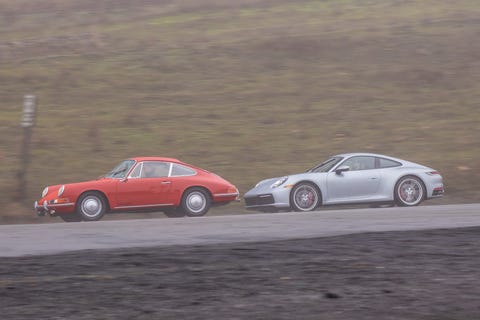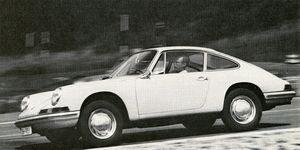
Andi HedrickCar and Driver
Porsche’s slope-shouldered 911 sports car is arguably one of the most recognizable automobiles in the world. It’s undergone 56 years of evolution, changing so slowly over its seven generations that no one could possibly question its lineage—except us. Now that the latest 992-generation 911 is here for the 2020 model year, we were curious about how much of the original 911’s DNA, if any, comes through in it. Is there a clear genetic relationship, or has it morphed into a completely different animal?
Our laboratory for this automotive 23andMe was a vintage-Porsche event staged by the Porsche Cars North America at Sonoma Raceway in northern California, where we drove a first-generation 911, a 1964 example meticulously restored by the Porsche Museum. And then we hopped into a new 911 Carrera S to gauge the effect of natural selection on the species.
A Time Machine
For the Porsche historians in the audience, we offer this clarification: The gorgeous old red car that we drove technically is not a 911 but rather a 901. Porsche built 82 cars tagged as 901s in 1964 before renaming the line 911 and continuing production with a few minor changes. The nomenclature switch was a result of Peugeot complaining that Porsche had appropriated its naming convention, which denoted model lines using three-digit numbers with a zero in the middle position. So, Porsche simply swapped the zero in the 901’s name for a one and moved on. Our car is number 57 of that original run of 82.
We treated it with the respect it deserves, and it deserved to be exercised. We drove it up and down California State Route 121, which borders the track, on a moody day when mist hung low over the rolling hills. The road, shiny with moisture, wound past the Gloria Ferrer, Cline, and Ram’s Gate wineries, by long rows of gnarled grape vines, and alongside fields of tawny scrub. It felt like a trip back in time.
We worked the vintage 901 through the five gears of its manual transmission, revved it close to its 6800-rpm redline, and tugged gently on its unassisted steering. We listened to its flat-six engine and listened even closer to what the 901 was telling us about its genetic connection to today’s 911.
Potent Evolution
From the moment you climb into the 901, its relationship to the new 992 is equally clear and distant. You face a five-gauge instrument cluster and behind you is a pair of jump seats—hallmarks present in the majority of 911s to date. But beyond that, the two felt like different branches of the same evolutionary tree.
You sit up in the 901 as if you’re riding on it; you drop down into a 992 like you’re wearing it. The 901’s cabin looks home-built compared to the rich furnishings and precise assembly quality of the modern-era 992. The view out the 901’s windshield is framed by tall front fenders that extend forward like cannon barrels. The 992’s driver looks out at a flattened and widened version of that same landscape. And, of course, the 901 is bereft of modern luxuries. The old car doesn’t even have seatbelts, let alone seat heaters. To warm the 901’s cabin, you reach down into the footwells and open small, sliding vents to let hot engine air in, just as in a similar-vintage Volkswagen Beetle.
On the road, the 901 hints at the vibrant, athletic bullet the 911 would eventually become. It’s light and lively at just 2376 pounds and 130 horsepower, though far from quick by today’s standards. The museum claims it takes about nine seconds to reach 60 mph and tops out at 130 mph. When the 901’s modern analog is equipped with its eight-speed PDK dual-clutch automatic, the 992 Carrera S’s 443 horsepower catapults its 3379 pounds to 60 mph in 2.9 seconds and, if you are to believe Porsche, on to 191 mph. Listen carefully to the din of the 901’s air-cooled 2.0-liter flat-six and you might be able to pick out faint strains of what would evolve into the seductive, high-rpm yowl of the 992’s liquid-cooled twin-turbo 3.0-liter flat-six. But you won’t hear much in the 901 above 60 mph other than wind noise.
Common Distant Lineage
Early 911s were legendary for their tendency to swap ends if you blazed into a corner too fast, so we were gentle with the nearly priceless 901 on Sonoma’s slippery pavement. Its manual steering is quick, and its handling is darty. The clutch feels intuitive to modulate, but the manual shifter is sloppy and a stretch to reach. Getting comfortable with the 901’s eccentricities is a learning process. The 992, however, is confidence incarnate: secure, locked-down, and foolproof. It won’t bite unless you ask it to do something beyond reason.
Parking these two cars side by side delivers possibly the most telling statement about how much of the original 911’s DNA has been passed down. There’s a certain family resemblance, but they look more different than alike. And the youngster has definitely been hitting the gym.
In the April 1965 edition of Car and Driver, we declared that the new Porsche 911 had “the stuff legends are made of.” There was no way to know that we’d be saying the same thing about its seventh-generation successor 56 years later. That opinion seems to be the only thing about the Porsche 911 that hasn’t evolved.
Source: Reviews - aranddriver.com





